Do You Feel the Trend Towards Diverse Families Is Positive or Negative?
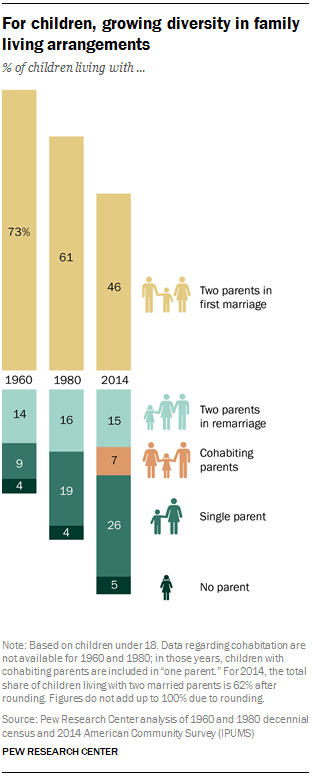 Family life is irresolute. Two-parent households are on the pass up in the U.s. equally divorce, remarriage and cohabitation are on the rise. And families are smaller at present, both due to the growth of unmarried-parent households and the driblet in fertility. Non only are Americans having fewer children, just the circumstances surrounding parenthood accept changed. While in the early on 1960s babies typically arrived inside a marriage, today fully four-in-x births occur to women who are single or living with a not-marital partner. At the same fourth dimension that family unit structures take transformed, so has the role of mothers in the workplace – and in the home. As more moms have entered the labor force, more than accept become breadwinners – in many cases, primary breadwinners – in their families.
Family life is irresolute. Two-parent households are on the pass up in the U.s. equally divorce, remarriage and cohabitation are on the rise. And families are smaller at present, both due to the growth of unmarried-parent households and the driblet in fertility. Non only are Americans having fewer children, just the circumstances surrounding parenthood accept changed. While in the early on 1960s babies typically arrived inside a marriage, today fully four-in-x births occur to women who are single or living with a not-marital partner. At the same fourth dimension that family unit structures take transformed, so has the role of mothers in the workplace – and in the home. As more moms have entered the labor force, more than accept become breadwinners – in many cases, primary breadwinners – in their families.
As a result of these changes, there is no longer one ascendant family course in the U.South. Parents today are raising their children against a backdrop of increasingly diverse and, for many, constantly evolving family forms. By dissimilarity, in 1960, the height of the postal service-Earth War II baby boom, there was 1 dominant family form. At that time 73% of all children were living in a family with two married parents in their beginning wedlock. By 1980, 61% of children were living in this type of family unit, and today less than one-half (46%) are. The failing share of children living in what is often accounted a "traditional" family has been largely supplanted by the ascension shares of children living with single or cohabiting parents.
Non only has the diversity in family unit living arrangements increased since the early on 1960s, only and so has the fluidity of the family. Non-marital cohabitation and divorce, forth with the prevalence of remarriage and (non-marital) recoupling in the U.S., make for family structures that in many cases proceed to evolve throughout a child's life. While in the past a child built-in to a married couple – every bit near children were – was very likely to grow up in a abode with those 2 parents, this is much less common today, as a kid's living arrangement changes with each aligning in the relationship condition of their parents. For example, i study institute that over a iii-year period, well-nigh three-in-ten (31%) children younger than 6 had experienced a major alter in their family or household construction, in the course of parental divorce, separation, marriage, cohabitation or death.
The growing complexity and diversity of families
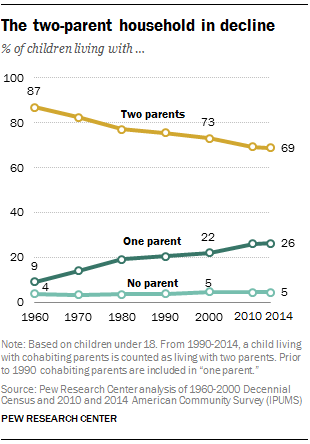 The share of children living in a two-parent household is at the lowest point in more than half a century: 69% are in this type of family organisation today, compared with 73% in 2000 and 87% in 1960. And even children living with ii parents are more likely to be experiencing a variety of family arrangements due to increases in divorce, remarriage and cohabitation.3 Today, fully 62% of children live with two married parents – an all-time low. Some 15% are living with parents in a remarriage and 7% are living with parents who are cohabiting.iv Conversely, the share of children living with one parent stands at 26%, up from 22% in 2000 and just 9% in 1960.
The share of children living in a two-parent household is at the lowest point in more than half a century: 69% are in this type of family organisation today, compared with 73% in 2000 and 87% in 1960. And even children living with ii parents are more likely to be experiencing a variety of family arrangements due to increases in divorce, remarriage and cohabitation.3 Today, fully 62% of children live with two married parents – an all-time low. Some 15% are living with parents in a remarriage and 7% are living with parents who are cohabiting.iv Conversely, the share of children living with one parent stands at 26%, up from 22% in 2000 and just 9% in 1960.
These changes have been driven in part by the fact that Americans today are exiting marriage at higher rates than in the past. Now, about ii-thirds (67%) of people younger than 50 who had e'er married are still in their first union. In comparing, that share was 83% in 1960.5 And while among men about 76% of first marriages that began in the late 1980s were even so intact 10 years after, fully 88% of marriages that began in the late 1950s lasted every bit long, according to analyses of Census Agency data.vi
The rise of single-parent families, and changes in two-parent families
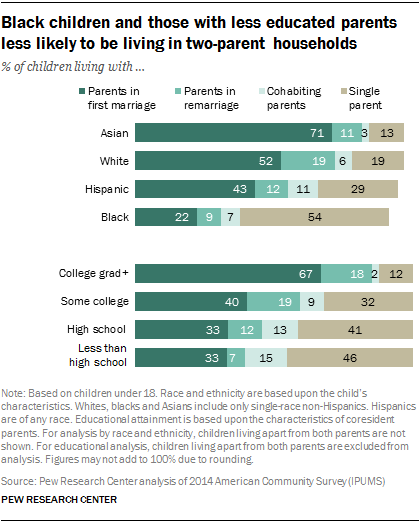 Despite the turn down over the past half century in children residing with ii parents, a majority of kids are withal growing up in this type of living organization.7 However, less than half—46%—are living with two parents who are both in their first marriage. This share is down from 61% in 1980viii and 73% in 1960.
Despite the turn down over the past half century in children residing with ii parents, a majority of kids are withal growing up in this type of living organization.7 However, less than half—46%—are living with two parents who are both in their first marriage. This share is down from 61% in 1980viii and 73% in 1960.
An additional xv% of children are living with 2 parents, at to the lowest degree one of whom has been married before. This share has remained relatively stable for decades.
In the remainder of two-parent families, the parents are cohabiting but are not married. Today 7% of children are living with cohabiting parents; however a far larger share will experience this kind of living arrangement at some point during their babyhood. For instance, estimates advise that about 39% of children will have had a mother in a cohabiting human relationship by the time they plough 12; and by the fourth dimension they plow 16, virtually half (46%) will have experience with their mother cohabiting. In some cases, this will happen because a never-married female parent enters into a cohabiting human relationship; in other cases, a female parent may enter into a cohabiting relationship after a marital breakup.
The decline in children living in 2-parent families has been offset by an almost threefold increase in those living with but ane parent—typically the mother.9 Fully i-4th (26%) of children younger than age eighteen are now living with a single parent, up from just ix% in 1960 and 22% in 2000. The share of children living without either parent stands at 5%; most of these children are existence raised by grandparents.10
The bulk of white, Hispanic and Asian children are living in two-parent households, while less than half of black children are living in this blazon of arrangement. Furthermore, at least half of Asian and white children are living with ii parents both in their showtime union. The shares of Hispanic and black children living with two parents in their beginning marriage are much lower.
Asian children are the most likely to be living with both parents—fully 84% are, including 71% who are living with parents who are both in their kickoff matrimony. Some 13% of Asian kids are living in a single-parent household, while xi% are living with remarried parents, and only iii% are living with parents who are cohabiting.
Roughly 8-in-ten (78%) white children are living with two parents, including about half (52%) with parents who are both in their first marriage and 19% with two parents in a remarriage; 6% have parents who are cohabiting. About one-in-five (19%) white children are living with a single parent.
Amid Hispanic children, ii-thirds live with ii parents. All told, 43% live with 2 parents in their commencement wedlock, while 12% are living with parents in a remarriage, and 11% are living with parents who are cohabiting. Some 29% of Hispanic children live with a single parent.
The living arrangements of black children stand in stark contrast to the other major racial and ethnic groups. The majority – 54% – are living with a single parent. Just 38% are living with two parents, including 22% who are living with ii parents who are both in their first marriage. Some 9% are living with remarried parents, and 7% are residing with parents who are cohabiting.
Children with at least one college-educated parent are far more likely to be living in a ii-parent household, and to be living with ii parents in a first union, than are kids whose parents are less educated.eleven Fully 88% of children who have at to the lowest degree one parent with a available's degree or more than are living in a ii-parent household, including 67% who are living with 2 parents in their beginning marriage.
In comparison, some 68% of children who have a parent with some higher feel are living in a ii-parent household, and just 40% are living with parents who are both in a kickoff marriage. Well-nigh six-in-10 (59%) children who have a parent with a high schoolhouse diploma are in a two-parent household, including 33% who are living with parents in their commencement union. Meanwhile, but over half (54%) of children whose parents lack a high school diploma are living in a two-parent household, including 33% whose parents are in their first spousal relationship.
Blended families
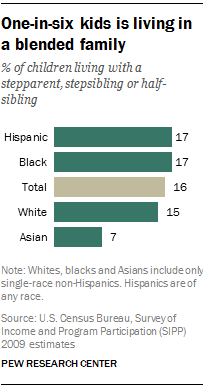 According to the most contempo data, 16% of children are living in what the Census Bureau terms "composite families" – a household with a stepparent, stepsibling or half-sibling. This share has remained stable since the early 1990s, when reliable data first became bachelor. At that fourth dimension fifteen% of kids lived in blended family households. All told, about 8% are living with a stepparent, and 12% are living with stepsiblings or half-siblings.12
According to the most contempo data, 16% of children are living in what the Census Bureau terms "composite families" – a household with a stepparent, stepsibling or half-sibling. This share has remained stable since the early 1990s, when reliable data first became bachelor. At that fourth dimension fifteen% of kids lived in blended family households. All told, about 8% are living with a stepparent, and 12% are living with stepsiblings or half-siblings.12
Many, but not all, remarriages involve composite families.13 According to data from the National Center for Wellness Statistics, 6-in-x (63%) women in remarriages are in blended families, and about half of these remarriages involve stepchildren who live with the remarried couple.
Hispanic, black and white children are every bit likely to alive in a blended family. About 17% of Hispanic and blackness kids are living with a stepparent, stepsibling or a half-sibling, as are 15% of white kids. Amid Asian children, however, 7% – a far smaller share – are living in blended families. This depression share is consistent with the finding that Asian children are more likely than others to be living with two married parents, both of whom are in their kickoff marriage.
The shrinking American family
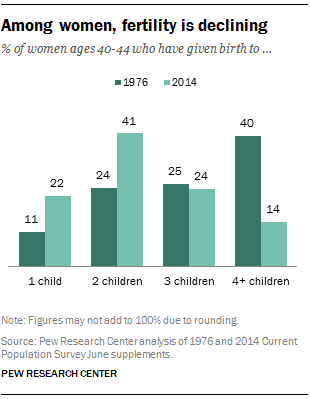 Fertility in the U.S. has been on the decline since the stop of the post-Earth War Ii infant nail, resulting in smaller families. In the mid-1970s, a 40% plurality of mothers who had reached the end of their childbearing years had given birth to four or more children.14 Now, a similar share (41%) of mothers at the end of their childbearing years has had two children, and just 14% accept had four or more children.15
Fertility in the U.S. has been on the decline since the stop of the post-Earth War Ii infant nail, resulting in smaller families. In the mid-1970s, a 40% plurality of mothers who had reached the end of their childbearing years had given birth to four or more children.14 Now, a similar share (41%) of mothers at the end of their childbearing years has had two children, and just 14% accept had four or more children.15
At the same time, the share of mothers ages 40 to 44 who have had only one child has doubled, from 11% in 1976 to 22% today. The share of mothers with three children has remained nigh unchanged at virtually a quarter.
Women's increasing educational attainment and labor force participation, and improvements in contraception, not to mention the retreat from spousal relationship, have all probable played a role in shrinking family unit size.
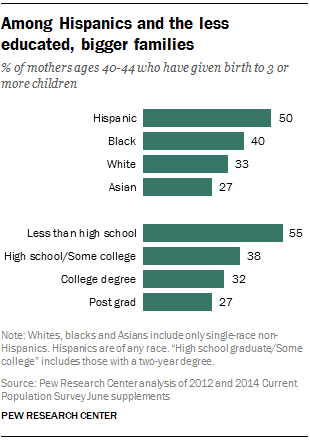 Family unit size varies markedly across races and ethnicities. Asian moms have the lowest fertility, and Hispanic mothers take the highest. Most 27% of Asian mothers and i-third of white mothers almost the finish of their childbearing years have had three or more children. Among blackness mothers at the finish of their childbearing years, four-in-ten have had three or more children, equally take fully half (l%) of Hispanic mothers.
Family unit size varies markedly across races and ethnicities. Asian moms have the lowest fertility, and Hispanic mothers take the highest. Most 27% of Asian mothers and i-third of white mothers almost the finish of their childbearing years have had three or more children. Among blackness mothers at the finish of their childbearing years, four-in-ten have had three or more children, equally take fully half (l%) of Hispanic mothers.
Similarly, a gap in fertility exists among women with different levels of educational attainment, despite recent increases in the fertility of highly educated women. For case, just 27% of mothers ages 40 to 44 with a post-graduate degree such as a master'south, professional or doctorate degree have borne three or more children, as have 32% of those with a bachelor's degree. Among mothers in the aforementioned historic period group with a high school diploma or some higher, 38% take had iii or more kids, while among moms who lack a high school diploma, the majority – 55% – have had iii or more children.
The rise of births to unmarried women and multi-partner fertility
Non only are women having fewer children today, only they are having them under dissimilar circumstances than in the past. While at 1 fourth dimension nearly all births occurred within union, these two life events are now far less intertwined. And while people were much more probable to "mate for life" in the past, today a sizable share take children with more than 1 partner – sometimes within marriage, and sometimes outside of it.
Births to unmarried women
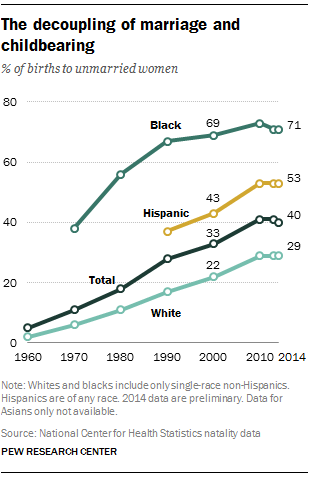 In 1960, just 5% of all births occurred exterior of marriage. By 1970, this share had doubled to 11%, and by 2000 fully 1-third of births occurred to unmarried women. Non-marital births continued to rise until the mid-2000s, when the share of births to unmarried women stabilized at around xl%.16
In 1960, just 5% of all births occurred exterior of marriage. By 1970, this share had doubled to 11%, and by 2000 fully 1-third of births occurred to unmarried women. Non-marital births continued to rise until the mid-2000s, when the share of births to unmarried women stabilized at around xl%.16
Not all babies born outside of a marriage are necessarily living with just ane parent, even so. The majority of these births now occur to women who are living with a romantic partner, according to analyses of the National Survey of Family Growth. In fact, over the by twenty years, nearly all of the growth in births outside of marriage has been driven by increases in births to cohabiting women.17
Researchers have constitute that, while marriages are less stable than they one time were, they remain more than stable than cohabiting unions. By analysis indicates that about one-in-5 children born within a spousal relationship will experience the breakup of that marriage by age 9. In comparison, fully half of children born within a cohabiting union will feel the breakdown of their parents by the aforementioned age. At the same fourth dimension, children born into cohabiting unions are more than probable than those built-in to single moms to someday live with two married parents. Estimates suggest that 66% will have done so past the fourth dimension they are 12, compared with 45% of those who were built-in to single not-cohabiting moms.
The share of births occurring outside of wedlock varies markedly beyond racial and ethnic groups. Amongst black women, 71% of births are now non-marital, every bit are virtually half (53%) of births to Hispanic women. In contrast, 29% of births to white women occur outside of a marriage.
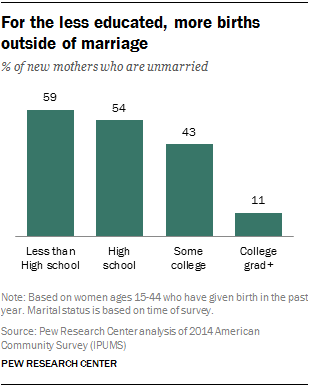 Racial differences in educational attainment explain some, but non all, of the differences in not-marital birth rates.
Racial differences in educational attainment explain some, but non all, of the differences in not-marital birth rates.
New mothers who are college-educated are far more likely than less educated moms to be married. In 2014 merely 11% of women with a college caste or more than who had a baby in the prior year were unmarried. In comparing, this share was about 4 times every bit loftier (43%) for new mothers with some college merely no college degree. Most half (54%) of those with merely a high school diploma were unmarried when they gave birth, equally were virtually half dozen-in-ten (59%) new mothers who lacked a high school diploma.
Multi-partner fertility
Related to non-marital births is what researchers phone call "multi-partner fertility." This measure reflects the share of people who have had biological children with more than one partner, either within or exterior of marriage. The increment in divorces, separations, remarriages and series cohabitations has likely contributed to an increment in multi-partner fertility. Estimates vary, given information limitations, but analysis of longitudinal information indicates that almost 20% of women near the stop of their childbearing years have had children past more than than one partner, every bit have about three-in-ten (28%) of those with two or more than children. Research indicates that multi-partner fertility is specially common among blacks, Hispanics, and the less educated.
Parents today: older and amend educated
While parents today are far less likely to exist married than they were in the past, they are more likely to exist older and to accept more teaching.
In 1970, the boilerplate new mother was 21 years old. Since that time, that age has risen to 26 years. The rise in maternal age has been driven largely by declines in teen births. Today, 7% of all births occur to women under the age of 20; every bit recently equally 1990, the share was nearly twice as high (13%).
While age at first birth has increased beyond all major race and ethnic groups, substantial variation persists across these groups. The average offset-fourth dimension mom amongst whites is at present 27 years old. The boilerplate historic period at start birth among blacks and Hispanics is quite a flake younger – 24 years – driven in office by the prevalence of teen pregnancy in these groups. Just 5% of births to whites take place prior to age xx, while this share reaches 11% for non-Hispanic blacks and ten% for Hispanics. On the other end of the spectrum, fully 45% of births to whites are to women ages 30 or older, versus only 31% amid blacks and 36% among Hispanics.
Mothers today are also far meliorate educated than they were in the past. While in 1960 merely 18% of mothers with infants at home had any college experience, today that share stands at 67%. This trend is driven in large part by dramatic increases in educational attainment for all women. While nearly half (49%) of women ages xv to 44 in 1960 lacked a high school diploma, today the largest share of women (61%) has at least some higher experience, and just 19% lack a loftier school diploma.
Mothers moving into the workforce
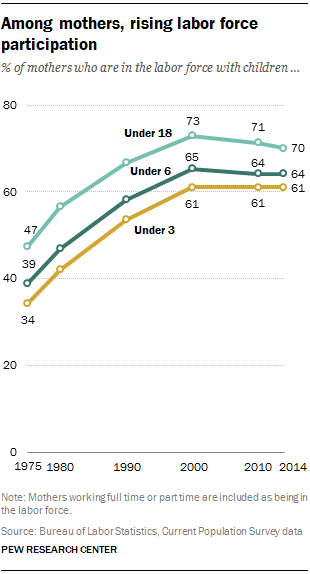 In add-on to the changes in family unit construction that have occurred over the past several decades, family life has been greatly affected by the movement of more and more mothers into the workforce. This increment in labor force participation is a continuation of a century-long trend; rates of labor strength participation among married women, especially married white women, have been on the rise since at least the turn of the 20th century. While the labor force participation rates of mothers accept more or less leveled off since about 2000, they remain far higher than they were four decades ago.
In add-on to the changes in family unit construction that have occurred over the past several decades, family life has been greatly affected by the movement of more and more mothers into the workforce. This increment in labor force participation is a continuation of a century-long trend; rates of labor strength participation among married women, especially married white women, have been on the rise since at least the turn of the 20th century. While the labor force participation rates of mothers accept more or less leveled off since about 2000, they remain far higher than they were four decades ago.
In 1975, the first year for which data on the labor forcefulness participation of mothers are bachelor, less than half of mothers (47%) with children younger than eighteen were in the labor forcefulness, and about a third of those with children younger than iii years old were working outside of the home. Those numbers changed rapidly, and, past 2000, 73% of moms were in the labor force. Labor strength participation today stands at lxx% amongst all mothers of children younger than 18, and 64% of moms with preschool-aged children. Near iii-fourths of all employed moms are working full time.
Amid mothers with children younger than eighteen, blacks are the near likely to be in the labor force –about three-fourths are. In comparison, this share is 70% amidst white mothers. Some 64% of Asian mothers and 62% of Hispanic mother are in the workforce. The relatively loftier proportions of immigrants in these groups likely contribute to their lower labor force interest – foreign-born moms are much less probable to be working than their U.S.-born counterparts.
The more instruction a female parent has, the more probable she is to be in the labor force. While about half (49%) of moms who lack a high school diploma are working, this share jumps to 65% for those with a loftier school diploma. Fully 75% of mothers with some college are working, as are 79% of those with a college caste or more.
Forth with their movement into the labor force, women, even more than men, take been attaining college and higher levels of education. In fact, among married couples today, it is more common for the wife to have more education than the husband, a reversal of previous patterns. These changes, along with the increasing share of single-parent families, mean that more than e'er, mothers are playing the function of breadwinner—often the primary breadwinner—within their families.
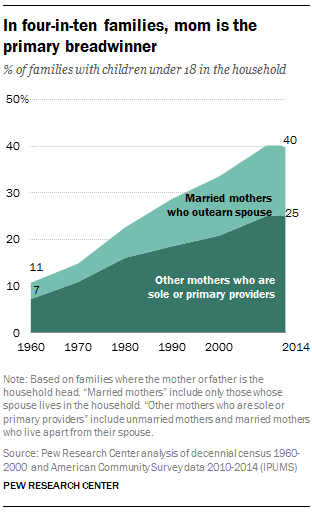 Today, 40% of families with children under 18 at home include mothers who earn the majority of the family income.18 This share is up from 11% in 1960 and 34% in 2000. The bulk of these breadwinner moms—eight.3 million—are either unmarried or are married and living apart from their spouse.19 The remaining 4.9 million, who are married and living with their spouse, earn more than their husbands. While families with married breadwinner moms tend to have higher median incomes than married-parent families where the father earns more than ($88,000 vs. $84,500), families headed by single mothers take incomes far lower than unmarried male parent families. In 2014, the median annual income for unmarried mother families was just $24,000.
Today, 40% of families with children under 18 at home include mothers who earn the majority of the family income.18 This share is up from 11% in 1960 and 34% in 2000. The bulk of these breadwinner moms—eight.3 million—are either unmarried or are married and living apart from their spouse.19 The remaining 4.9 million, who are married and living with their spouse, earn more than their husbands. While families with married breadwinner moms tend to have higher median incomes than married-parent families where the father earns more than ($88,000 vs. $84,500), families headed by single mothers take incomes far lower than unmarried male parent families. In 2014, the median annual income for unmarried mother families was just $24,000.
Breadwinner moms are particularly common in black families, spurred past very high rates of single motherhood. Nigh 3-fourths (74%) of black moms are breadwinner moms. Most are single or living apart from their spouse (61%), and the balance (thirteen%) earn more than their spouse. Among Hispanic moms, 44% are the chief breadwinner; 31% are unmarried, while 12% are married and making more than their husbands. For white mothers, 38% are the primary breadwinners—xx% are unmarried moms, and 18% are married and have income higher than that of their spouses. Asian families are less likely to accept a woman as the main breadwinner in their families, presumably due to their extremely low rates of unmarried maternity. Just 11% of Asian moms are unmarried. The share who earn more than their husbands—20%— is somewhat higher than for the other racial and ethnic groups.
The flip side of the motility of mothers into the labor force has been a dramatic decline in the share of mothers who are now stay-calm moms. Some 29% of all mothers living with children younger than 18 are at home with their children. This marks a modest increase since 1999, when 23% of moms were dwelling house with their children, but a long-term decline of nearly xx percentage points since the late 1960s when about one-half of moms were at home.
While the image of "stay-at-domicile mom" may conjure images of "Exit It to Beaver" or the highly affluent "opt-out mom", the reality of stay-calm motherhood today is quite different for a big share of families. In roughly iii-in-ten of stay-at-habitation-mom families, either the male parent is not working or the mother is single or cohabiting. Every bit such, stay-at-habitation mothers are mostly less well off than working mothers in terms of educational activity and income. Some 49% of stay-at-dwelling house mothers take at near a high-schoolhouse diploma compared with xxx% among working mothers. And the median household income for families with a stay-at-abode mom and a full-fourth dimension working dad was $55,000 in 2014, roughly half the median income for families in which both parents work full-time ($102,400).twenty
Source: https://www.pewresearch.org/social-trends/2015/12/17/1-the-american-family-today/
0 Response to "Do You Feel the Trend Towards Diverse Families Is Positive or Negative?"
Post a Comment